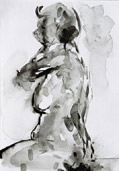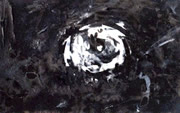 |
 |
 |
 |
 |
INTIMACY AND MORTALITY: FINER’S PEOPLE
Robin Gibson
This article is reproduced from the catalogue:
STEPHEN FINER - Paintings
published by Art Space Gallery
to coincide with the exhibition: 2 July - 31 July 2004
Stephen Finer is reluctant to talk about his work except in the most
practical of terms (‘that one took me a very long time… I don’t know
why…’). The little whitewashed studio is freckled with splashes of
colour and light as these new, mostly small works jostle for my
attention. I can probably find some general drift in style and execution
that represents a development in his work from the last exhibition. It is
perhaps only the inclusion of the small dark torso from the 1980s
(Naked woman lying) that gives me the illusion that there is some
progression in the work from dark to light. The most recent in a series
of portraits of Lord Shawcross (1996) is also painted in the steely
greys and fierce colours that I associate with Finer’s work of the
1980s. It is perhaps his most powerful portrait yet of the distinguished
elder statesman and positively bristles with character and life. Shifts
in Finer’s painting, however, are more subtle than a mere change of
palette so I begin looking for other kinds of visual evidence to find out
what has been going on in the canvasses that are precariously
balanced round the room in front of me.
There are some small postcard-sized watercolours, mostly in
monochrome that are evidently a departure. Some of them, like
Seated woman and Face have more obvious elements of 'drawing’ in
them that are accentuated by the lack of colour and relatively
economical application of the (for Finer) new medium. It is not only the
switch in scale, therefore, that allows a subtly different change in the
way these works can be read. The nude Seated woman has an almost old-masterish, Rembrandtesque spontaneity and
immediacy about it, a new slant on one of Finer’s most enduring
subjects. The androgynous Face has a monumental quality and
dignity which might, despite its scale, suggest some colossal Greek
or even Oceanic head. Finer expects our reading of his paintings to
be subjective, but even the title, Face, denotes an enormous change
in approach from an artist who has never previously ventured anything
more specific than Head.
From the face, Finer moves even closer into his subject with his study of an eye. I am reminded that, in the mid-eighteenth century, one of the byways of British portraiture was a mercifully short-lived fashion for miniatures of individual eyes. These horribly realistic little objects arose, ostensibly, from the belief that the eye was the mirror of the soul, and usually depicted the eye of a loved one. It is not beyond the bounds of possibility that similar, though post-Freudian intentions, were at the back of Finer’s mind when he began the painting. But what an eye! ‘Eye of the storm’ might seem more appropriate as the thickly applied pigment draws us into a Kokoschkaesque frenzy, down into the bottomless vortex of the iris. This is the work which had taken Finer many months to resolve.
As a record of his reaction to the subject, it denotes a willingness to come to terms with subject matter that for him, is entirely new. In the wonderfully suggestive (and posthumous) portrait of architect Sir Denys Lasdun, the movement and character implicit in the half-profile are again stabilised by a large brushstroke, here suggesting rather than describing the left eye. In a portrait of Marlene Dietrich, Finer delineates, with calligraphic delicacy, the heavy false eyelashes that were a key weapon in the aging actress’s defences against advancing old age. This is Finer’s most recent portrait of the film star turned cabaret artiste and, catching her characteristic gesture of the outstretched arm and her sagging lurexclad bosom, seems a more substantial memorial than the first sparkling head he painted as long ago as 1988.
Lasdun, Dietrich, Bowie, Shawcross, Garland, all names to conjure with, but all now part of the openly autobiographical programme which is emerging in Finer’s paintings. Twenty years ago, Finer would have suppressed the personal element in his paintings and portraits and titled them simply Man of 45 or Woman lying down in order to persuade us, the viewers, to concentrate on the paintings for their own sake. He is now more relaxed about revealing his inspirations, interests and affections. Maturity has also brought with it greater confidence in his abilities and beliefs, but there is now a sense that there is no more virtue in being impersonal than there is in being overconfiding.
As with Auerbach, familiarity with his subject matter seems to inspire Finer to new heights. The self-portrait that dominates Gill Bastedo and Stephen Finer, 1998, is his first essay in the genre and an extraordinary achievement in its own right. There are a number of things about this painting that immediately strike the viewer as rather odd, but it is precisely these oddities which make it such an intensely personal and powerful work. The fact that it is painted in deceptively cool monochrome black and white might, in the context of Finer’s work, legitimately be assumed to put a bit of a damper on a painting celebrating a personal relationship of great warmth. Finer’s skill is such, however, that the portrait is vibrant with life and feeling, to the extent that I found myself increasingly unaware that there wasn’t any colour. He spares neither himself nor his partner the severity of his observation. An image of the great American comedian Phil Silvers was the first that came to mind (perhaps especially because Silvers is only ever seen on our televison screens in black and white). The difference in scale between the two figures on the one hand accurately reflects their relative difference in height but is actually far more descriptive of the artist’s protectiveness and tenderness towards his companion.
When Norbert Lynton wrote his introduction to the catalogue of Finer’s exhibition at the Bernard Jacobson Gallery in 1995, he agonised as a good modernist, about having to resort to the word ‘beauty’ in relation to Finer’s paintings. Possibly less squeamish than he. and with less to lose, there is no hesitation in my mind that ‘beauty’ is the only word left once you have tried, as I have, to analyse and dissect some of the motivation and method behind the work. Both the double and single Girl Bastedo & Stephen Finer, 1998 oil on canvas 161/8 x 20ins / 41 x 51cm portraits of Patrick Garland for instance are characterised by the most stunning passages of paint. The sudden touch of brilliant yellow on the neck here, and patch of vibrant red there, have an emotional impact which totally transforms the work as surely as if Finer had placed a bomb in his sitter’s hands.
Robin Gibson was formerly the Chief Curator at the National Portrait Gallery and is the author of:
Painting the Century
101 Portrait Masterpieces 1900-2000, NPG Publication.
His
previous publications include books on the photographer Madame Yevonde, the Sitwells and twentieth-century and contemporary portraiture.